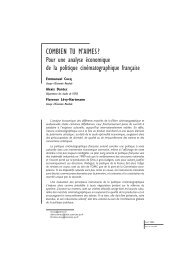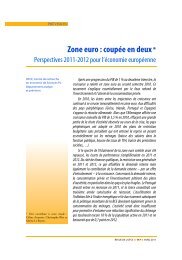direct multi-step estimation and forecasting - OFCE - Sciences Po
direct multi-step estimation and forecasting - OFCE - Sciences Po
direct multi-step estimation and forecasting - OFCE - Sciences Po
You also want an ePaper? Increase the reach of your titles
YUMPU automatically turns print PDFs into web optimized ePapers that Google loves.
Direct <strong>multi</strong>-<strong>step</strong> <strong>estimation</strong> <strong>and</strong> <strong>forecasting</strong><br />
9.2 A general forecast-error taxonomy<br />
We now borrow from Clements <strong>and</strong> Hendry who suggest in Clements <strong>and</strong> Hendry (1998b) <strong>and</strong><br />
Hendry (2000) a general forecast error taxonomy which helps us in assessing the advantages of<br />
<strong>multi</strong>-<strong>step</strong> <strong>estimation</strong>. We use the framework presented above but for ease of exposition modify it<br />
slightly. Notice that in (20), f x (·), if it represents the true DGP, provides the—potentially time<br />
dependent—joint density of x t at time t, conditional on X t−p<br />
t−1 = (x t−1, ..., x t−p ), <strong>and</strong> z t . Assume,<br />
without loss of generality, that {z t } contains only deterministic factors—such as intercepts, trends<br />
<strong>and</strong> indicators—<strong>and</strong> that all stochastic variables are included in {x t }. As previously, it is desired to<br />
forecast x T +h , or perhaps of function thereof (e.g. if z t originally contained stochastic variables),<br />
over horizons h = 1, ..., H, from a forecast origin at T . Now, the dynamic model does not coincide<br />
with the data generating process <strong>and</strong> it specifies the distribution of x t conditional on X t−r<br />
t−1 , with lag<br />
length r, deterministic components d t <strong>and</strong> implicit stochastic specification defined by its parameters<br />
ψ t . This model is fitted over the sample t = 0, ..., T, so that parameter estimates are a function of<br />
the observations, represented by:<br />
̂ψ T = Ψ T<br />
(<br />
˜X0 T , D 0 T<br />
)<br />
, (23)<br />
where ˜X denotes the measured data <strong>and</strong>, as before D 0 t = (d t , ..., d 0 ). A sequence of forecasts<br />
{̂x T +h|T } is produced as a result. The subscript on ̂ψ in (23) denotes the influence of the sample<br />
size. Let ψ e T = E T<br />
[̂ψT<br />
], where it exists. Because the underlying densities may be changing over<br />
time, all expectation operators must be time dated. Future values of the stochastic variables are<br />
unknown, but those of deterministic variables are known; there, therefore, exists a function g h (·)<br />
such that<br />
̂x T +h|T = g h<br />
(<br />
˜XT<br />
−r+1<br />
T<br />
, D T +1<br />
T +h , ̂ψ T<br />
)<br />
. (24)<br />
The corresponding h–<strong>step</strong> ahead expected forecast error is, thus, the expected value of e T +h|T =<br />
x T +h − ̂x T +h|T , <strong>and</strong> is given by<br />
]<br />
E T +h<br />
[x T +h − ̂x T +h|T | X 0 T , {Z ∗ } 0 T +h<br />
,<br />
where the actual values of the deterministic factors over the forecast period (including any deterministic<br />
shifts) are denoted by {Z ∗ } T +1<br />
T +h <strong>and</strong> {Z∗ } 0 T +h = {Z ∗ } T +1<br />
T +h , Z0 T ; <strong>and</strong> the<br />
[<br />
]<br />
expectation<br />
36








